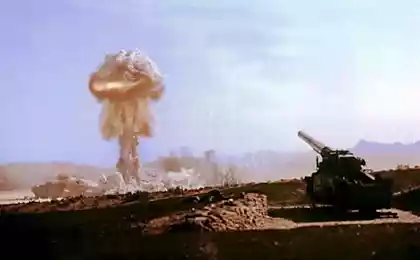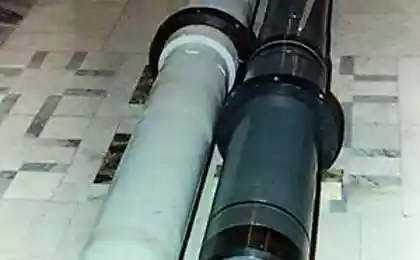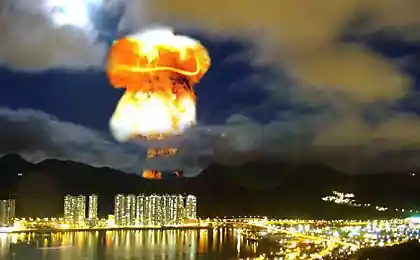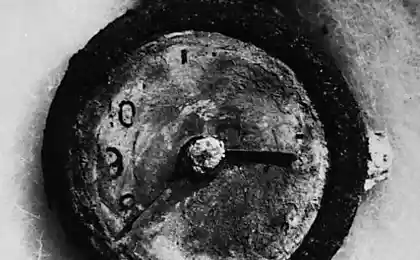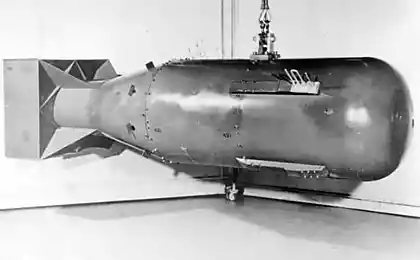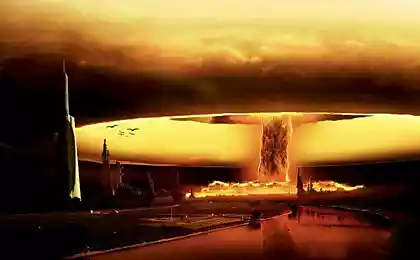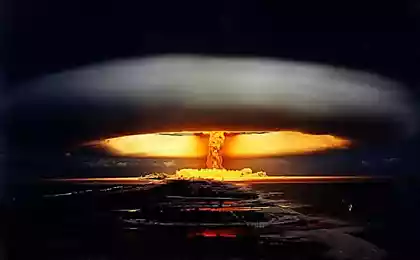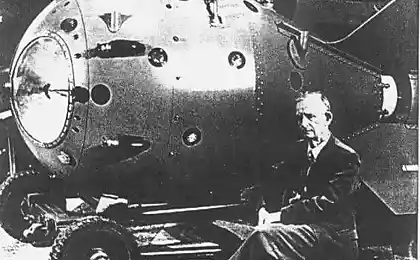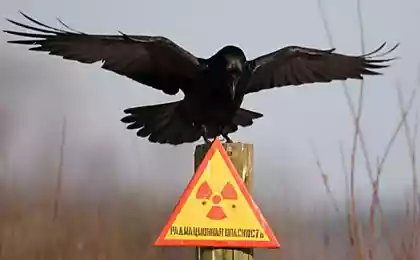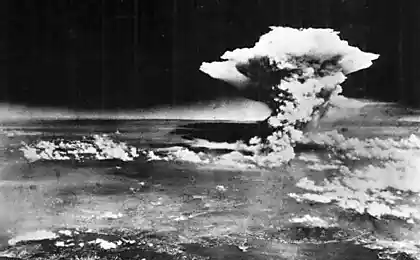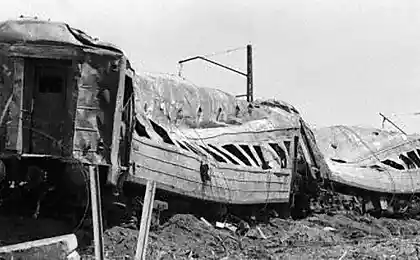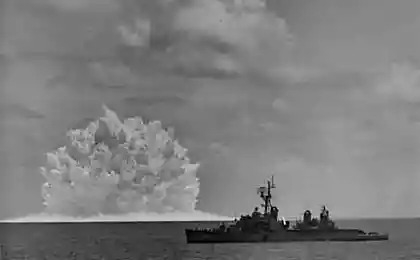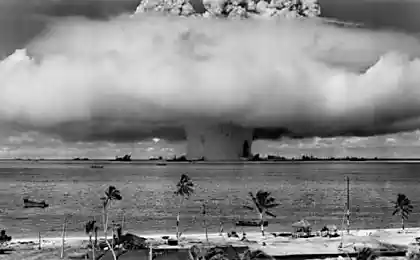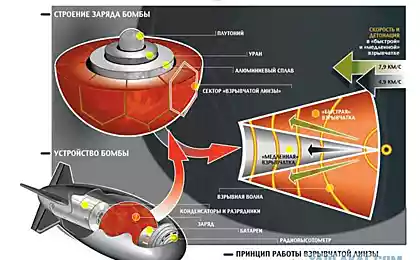1078
Effects of a nuclear explosion

Depending on the capacity of the charge and the conditions of the explosion energy of the explosion is distributed as follows:
The shock wave - from 40 to 60%
The light - 30-50%
Ionizing radiation - 5%
Radioactive contamination - 5-10%
The main factors affecting - the shock wave and light radiation - similar to the damaging factors of conventional explosives, but much more powerful.
Shockwave
Most of the damage caused by a nuclear explosion, caused by the action of the shock wave. A shock wave is a shock wave in a medium that moves with supersonic speed. At atmospheric explosion shock wave - a small area in which there is an almost instantaneous increase in the temperature, pressure and air density. Directly behind the shock front generated strong air currents, which can reach a speed of several hundred kilometers per hour. The shock wave destroys buildings, structures and affects vulnerable people.
Most of the buildings, except in fortified seriously damaged or destroyed by excessive pressure 2160-3600 kg / m (0, 22-0, 36 atm).
The energy is distributed throughout the distance, because of the strength of the shock wave decreases in proportion to the cube of the distance from the epicenter.
Protection against shock waves for a man is a haven. In the open area of the shock wave action is reduced by various depressions, obstacles the terrain.
The light
The light - a stream of radiant energy including the ultraviolet, visible and infrared regions of the spectrum. The source of light is a fireball explosion - heated to a high temperature and vaporized part of the munition, the surrounding soil and air. When the air blast fireball represents a ball in ground - hemisphere.
The maximum temperature of the surface of the luminous area is typically 5700-7700 ° C. When the temperature drops to 1700 ° C, glow stops. The light pulse continues from fractions of a second to several seconds, depending on the power and explosion conditions. Approximately, the duration of the glow in seconds equal to the root of the third degree of the power of the explosion in kilotons. The intensity of the radiation may exceed 1000 W / cm (for comparison - the maximum intensity of sunlight 0, 14 W / cm).
The result of the light emission can be inflammation and fire objects, melting, charring, large thermal stresses in the materials.
Under the influence of light on human burns appear open and protected areas of the body clothing, and eye damage may occur.
Protection from exposure to light can serve as an arbitrary opaque barrier.
In case of fog, haze, dust, high and / or light smoke exposure is also reduced.
Ionizing radiation
Ionizing radiation (ionizing radiation) is a gamma-ray and neutron flux emitted from the core of a nuclear explosion for units or tens of seconds.
The radius of the radiation injury in explosions in the atmosphere is less than the radius of the defeat of the light and shock wave, because it is strongly absorbed by the atmosphere. Ionizing radiation affects people only at a distance of 2-3 km from the site of the explosion, even for large power charges, but a nuclear warhead can be specially designed in such a way as to increase the proportion of ionizing radiation to cause maximum damage to manpower (so-called neutron weapons). At high altitudes in the stratosphere and space penetrating radiation and electromagnetic pulse - the main affecting factors.
Ionizing radiation can cause reversible and irreversible changes in the material, electronic, optical and other devices due to violations of the crystal lattice of the substance and other physical and chemical processes under the influence of ionizing radiation.
Protection against ionizing radiation are different materials, oslablinyuschie gamma radiation and neutron flux. Its level is reduced by 10 times after the passage of 11 cm steel or concrete 35 cm or 50 cm of soil / masonry or timber 1 m.
Electromagnetic pulse
When a nuclear explosion as a result of strong currents in the ionized radiation and light emission air there is a strong alternating electromagnetic field, called an electromagnetic pulse (EMP). Although it has no effect on the human impact of EMP damages electronics, electrical appliances and power lines. In addition, a large number of ions, which arose after the explosion and prevents the propagation of radio waves and radar stations. This effect can be used to blind the system of missile warning.
The strength of the EMR varies depending on the height of explosion in the range of 4-30 km, it is relatively weak in the explosion more than 4 km, and is particularly strong at the height of undermining the more than 30 km. (See, for example, an experiment on high-altitude detonation of nuclear charge Starfish Prime) .
The emergence of the EMP is as follows:
Ionizing radiation emanating from the center of the blast passes through the elongated conductive objects.
Gamma rays are scattered by free electrons, which leads to a rapidly changing current pulse in the conductors.
Field-induced current pulse is emitted into the surrounding space, and extends at a velocity of light, with a distorted temporarily and fading.
Under the influence of EMR in all the conductors induced high voltage. This leads to insulation breakdown and failure of electrical appliances - semiconductor devices, various electronic components, transformer substations, etc... In contrast to semiconductors, electron tubes are not exposed to strong radiation and electromagnetic fields, so they are a long time continued to be used by the military. < br />
Radioactive contamination
Radioactive contamination - the result of falling out of the air in the clouds lifted a significant amount of radioactive substances. Three main sources of radioactive substances in the area of the explosion - fission products of nuclear fuel, the unreacted part of the nuclear charge, and radioactive isotopes formed in soil and other materials under the influence of neutrons (an induced activity).
Settling on the surface of the earth in the direction of the cloud, creating a radioactive products of the explosion site, called the radioactive trace. The density of contamination in the vicinity of the explosion and the next movement of the radioactive cloud decreases with distance from the center of the explosion. Form follows can be very diverse, depending on the environmental conditions.
Radioactive explosion products emit three types of radiation: alpha, beta and gamma. The time of their impact on the environment is very long lasting.
In connection with the natural process of decay of radioactivity decreases, especially sharply this happens in the first hours after the explosion.
The defeat of the human and animal exposure to radiation contamination can be caused by external and internal exposure. Severe cases may be accompanied by radiation sickness and death.
